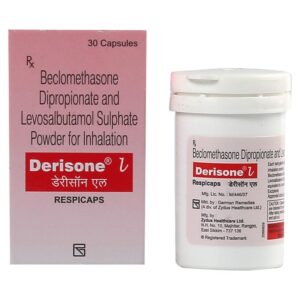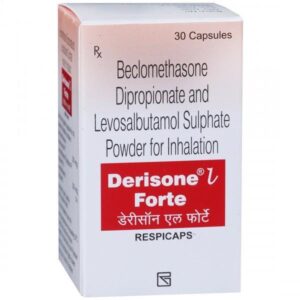BECLOMETHASONE + SALBUTAMOL
Beclomethasone: Beclomethasone is a corticosteroid medication that is primarily used as an anti-inflammatory and immunosuppressant. It is commonly prescribed for the treatment of conditions such as asthma, allergic rhinitis (hay fever), and certain skin disorders.
The mechanism of action of beclomethasone involves its ability to bind to glucocorticoid receptors, which are present in nearly all cells of the body. Upon binding, beclomethasone modulates gene transcription, leading to the inhibition of the production of inflammatory chemicals and the reduction of immune system activity. This helps to decrease inflammation and prevent the immune system from overreacting.
Beclomethasone is available in different forms, such as inhalers for asthma or nasal sprays for allergic rhinitis. The dosage and frequency of use will vary depending on the specific condition being treated. It is important to follow the prescribed dosage instructions provided by the healthcare provider.
As with any medication, there may be potential side effects associated with beclomethasone. Common side effects include throat irritation, coughing, hoarseness, headache, and nasal discomfort when using a nasal spray. Inhalation of beclomethasone can also lead to oral thrush or yeast infection in the mouth and throat if not properly rinsed after use. Long-term use of beclomethasone at high doses can sometimes lead to systemic side effects such as adrenal suppression, osteoporosis, and increased susceptibility to infections.
It is crucial to consult a healthcare professional before starting or changing any medication, including beclomethasone, to ensure appropriate use and to monitor for any potential side effects.
Salbutamol: Salbutamol, also known as albuterol, is a medication commonly used to treat bronchospasm, which is narrowing of the airways in conditions like asthma, chronic obstructive pulmonary disease (COPD), and bronchitis. It belongs to a class of drugs called beta-2 adrenergic agonists.
The primary mechanism of action of Salbutamol is its bronchodilatory effect. Upon inhalation or oral administration, Salbutamol binds to beta-2 adrenergic receptors in the smooth muscle of the airways. This binding stimulates the receptors, causing relaxation of the smooth muscles and widening of the airways, thus relieving bronchospasm and improving airflow.
Salbutamol can be administered through inhalation using a metered-dose inhaler (MDI) or a nebulizer. The usual starting dose for adults and children over 12 years old is 2 puffs (100-200 mcg) every 4-6 hours as needed for immediate relief. In some cases, a higher dose of up to 4 puffs may be required. For children aged 4-11 years, the usual dose is 1-2 puffs every 4-6 hours as needed.
Common side effects of Salbutamol include headache, tremor (shaking), increased heart rate (tachycardia), palpitations, muscle cramps, and insomnia. These side effects are usually mild and temporary. However, if they persist or worsen, it is important to consult a healthcare professional.
Rare but serious side effects may include chest pain, rapid or irregular heartbeat, severe dizziness, and allergic reactions (e.g., rash, itching, swelling, severe dizziness, difficulty breathing). If any of these occur, immediate medical attention should be sought.
It is worth noting that while Salbutamol provides quick relief of symptoms, it is not intended for long-term control of asthma or other chronic respiratory conditions. In such cases, other maintenance medications may be prescribed. It is important to follow the prescribed dosage and consult a healthcare professional for specific instructions tailored to individual needs.


